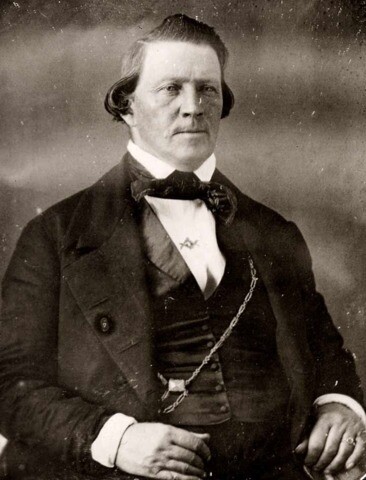Why did Joseph Smith become a Freemason? What is the relationship between Masonic lodge rites and Latter-day Saint temple ordinances? Here are 5 fascinating facts about Latter-day Saints and Masons.
1. The first five Latter-day prophets were Freemasons.
Joseph Smith, Brigham Young, John Taylor, Wilford Woodruff, and Lorenzo Snow all were members of the fraternity. All joined while living with the Saints in Nauvoo.

2. Joseph Smith joined the Masons in Nauvoo in March 1842.
Why would the Prophet join the Masons? In his essay “Freemasonry and the LDS Temple Endowment,” as found in the new book A Reason for Faith, Stephen C. Harper writes, “Joseph likely pondered the fraternal ceremony as he contemplated how he could prepare his followers for what awaited them in the new temple, how he might best teach them what he had learned over time from angels, from translating ancient records by the power of God, and from what he called ‘time, and experience, and careful and ponderous and solemn thoughts.’”
He continues, “Joseph knew that preparing hearts and minds to receive all that God had in store couldn’t be done easily. But he was not one to conclude that it couldn’t be done at all. So, as angels had done with him, and he had done with his followers before, he started with what he had and used what the Saints found familiar to lead them to further light and knowledge.”
3. The Church and Masonry use several of the same symbols.
Though the same symbols are used, there are many references to these symbols in Latter-day Saint history occurring well before Joseph Smith became a Freemason. In fact, Matthew B. Brown, author of Exploring the Connections Between Mormons and Masons, has found several references prior to 1842. For example:
All-Seeing Eye
1828–29: “I pray the God of my salvation that He view me with His all-searching eye” (2 Nephi 9:44).
May 1836: “God is not mocked with impunity. His all-seeing eye beholds you at all times. . . . His all-seeing eye surveys the whole of His vast creation” (remark by John Whitmer).
Handclasp
27 June 1839: Joseph Smith taught the members of the First Presidency and Quorum of the Twelve Apostles one of “the keys of the kingdom of God,” which was how to detect the nature of an otherworldly visitor by means of a handclasp.
22 July 1840: Joseph Smith Jr. had a scribe write in a letter to William W. Phelps, “I shall be happy once again to give you the right hand of fellowship.”
Holiness to the Lord
April 1830: “walking in holiness before the Lord” (D&C 20:69).
25 June 1833: The First Presidency of the Church wrote in a letter that each of the 24 temples in Jackson County, Missouri, was to be adorned with the inscription, “HOLINESS TO THE LORD” (History of the Church, 1:359).
Bees
1829: Honeybees called “deseret” (Ether 2:3).
November 1832: The disciple of Jesus Christ is to have “industry” like the “bees” (Evening and Morning Star, vol. 1, no. 6).
4. There are similarities between the Masonic and temple ordinances. However, the relationship between the two should not be oversimplified or overstated.
“Some people reason that Joseph Smith initiated men and women into the endowment ordinances after he was initiated into Freemasonry; therefore, the temple rituals derived from Masonry. One problem in this theory is that Freemasonry itself borrowed much of its ritual and ceremony from elements preserved since antiquity,” Harper explains in his essay “Freemasonry and the LDS Temple Endowment,” as found in A Reason for Faith.
He continues, “It may be that some ritual forms were adapted from Masonic traditions, but the endowment teaches a divine plan of creation, Fall, and redemption through Christ—promising those who covenant to keep God’s laws that they will gain power over the effects of the Fall.”
Similarly, Brown writes, “And there was no mistaking that there were some resemblances between the two rituals for, as Heber C. Kimball wrote just a month after being endowed, ‘There is a similarity of Priesthood in Masonry. And yet, no incredulous cry about bootlegging or fraud rang out from this group against the Prophet.’”
5. Early Church leaders agreed that Freemasonry could be traced back to the priesthood.
In his book Exploring the Connection Between Mormons and Masons, Matthew B. Brown includes several statements from prominent Latter-day Saints in the early Church. He writes:
“[Such quotes] establish the viewpoint of some 19th century [Latter-day Saints] with regard to the origin of Freemasonry. The first statement comes from Joseph Smith's scribe Willard Richards and was written by him on or very near the day when the Prophet was raised to the degree of Master Mason. The statements by Heber C. Kimball (a contemporary record) and Benjamin F. Johnson (a reminiscent account) reflect the thought of Joseph Smith on the matter.
“The message behind all of these statements is consistent—there are similarities between Freemasonry and the [Latter-day Saint] endowment because Masonry is a product of apostasy or degeneration from a priesthood-based prototype. Latter-day Saints possess the authentic version.”
Consider the following examples:
Willard Richards (16 March 1842): “Masonry had its origin in the Priesthood. A hint to the wise is sufficient.”
Heber C. Kimball (17 June 1842):“ There is a similarity of priesthood in Masonry. Brother Joseph [Smith] says Masonry was taken from priesthood.”
Benjamin F. Johnson (1843): Joseph Smith “told me Freemasonry, as at present, was the apostate endowments, as sectarian religion was the apostate religion.”
Joseph Fielding (December 1843): The Latter-day Saint temple ordinances are “the true origin of Masonry.”
Heber C. Kimball (9 November 1858): “The Masonry of today is received from the apostasy. . . . They have now and then a thing that is correct, but we have the real thing.”
BONUS FACT: Mozart, Napoleon, Walt Disney, and 13 U.S. presidents were also Freemasons.

